
After a two-season hiatus, here we go again with Jason moofang’s super-late ranked impressions of the season! What the heck are brainmarks you ask? Here’s the old paste of the FAQ:
| Spoilered: What are brainmarks? | Show |
|---|---|
Fall 2012 hasn’t been quite as spectacular as I had hoped it’d be viewing the previews. Don’t get me wrong, there is plenty to watch – there just isn’t a lot of promise as far as hitting pantheon-class is concerned. In general there seems to be a lack of ambitiously premised shows, made up for somewhat by the abundance of simpler but nonetheless entertaining offerings. It’s not necessarily a bad thing, but it does take away a little from the anticipation, compared for example to Fall last year.
Being the slowpoke that I am, I’m actually a couple weeks behind on most of these shows, so I’m just gonna go it clean and announce the number of episodes I’ve seen of each brainmarked show at the time of this writing. Also, amongst equally mediocre crop, I tend to favor those of the slice of life and comedic genre as a matter of personal taste. With that caveat in mind, let us dive in!
Brainmark #7: Sukitte Ina Yo
Episode seen: 2
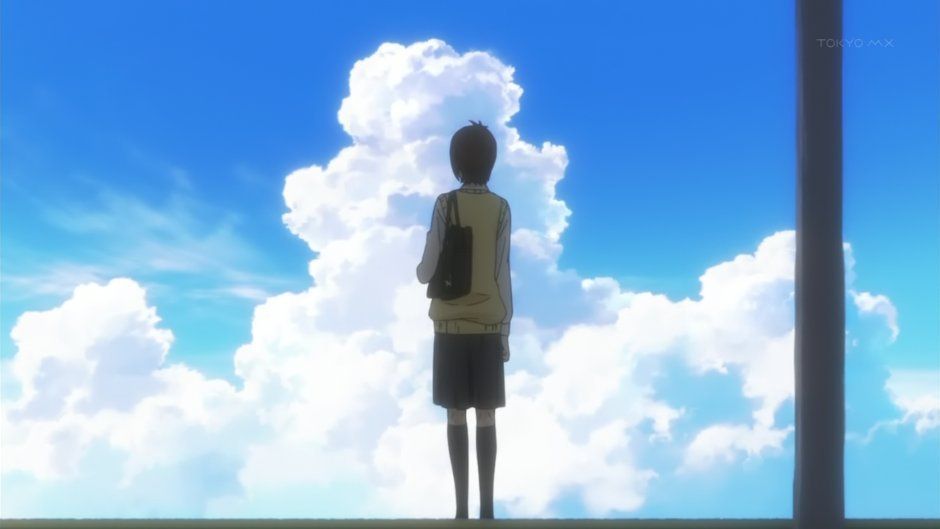
Interestingly, opinions are rather divided regarding the sizable block of shoujo offerings this season. Probably not too surprising: I think each show emphasizes different strengths and glosses over different things. Sukitte Ina Yo or “Say I love you” balances a homely, comfortably paced, quiet-but-heartfelt style against a lot of cheap-ish shoujo tropes and a nagging potential for cheesy drama. While Mei makes a decent-ish heroine, the guys in this show are quite those of the shoujo-manga superhero variety – having the enigmatic power to manage to be at the right place to do the right things at the right time. It’s one of those comes-with-the-genre things I guess. However, the skies are very pretty. Sukitte Ina Yo has some of the most breathtaking backdrops of open, enveloping skies you’ll find this season, and that counts. Ambiance and pacing can go a long way in relatively simple, romance-centric stories like these, and Sukitte Ina Yo scores very well in both departments. It doesn’t look like this show will be breaking any records, but if it keeps going the way it currently is, it should work out to be a simple but pleasant watch.
Brainmark #6: Psycho-Pass
Episodes seen: 1

Psycho-Pass is clearly one of the most ambitious shows this season. It is set in a somewhat dystopic world quite like ours yet with boldly imagined twists in place clearly aimed at provoking thought and raising ideas. Which is really great. And yet episode 1 had some unsettling flaws that really dampened my first impressions of the show. We have an interesting setting where authorities are able to pre-ascertain a person’s criminality likelihood and are apparently authorized to preemptively take action against people deemed dangerous in such a way, and episode one wastes no time in setting out to explore the philosophical difficulties of such a system: pitting the raised criminality-likelihood of a mentally distraught victim against her innocence and clear need of help. It’d all be really cool if the show didn’t feel so… narcissistic. It felt like the show was in love with itself and couldn’t resist fawning over every nook and cranny, resulting in everything feeling uniformly deliberate and painstakingly, almost cheesily slow. Even the gun took full seconds to transition from stun to kill mode, in an elaborate transformation sequence during which the wielder is apparently expected to just sit and watch the quarry flee. Don’t get me wrong, the ambitious premise makes this one of the few shows of the season with a real shot (and a real intent) of achieving greatness, but this could be the next GITS.. or the next Guilty Crown. The fact that I haven’t managed to get myself to sit down and watch episode 2 yet betrays which direction it is currently leaning towards.
Brainmark #5: Tonari no Kaibutsu-kun
Episodes seen: 3
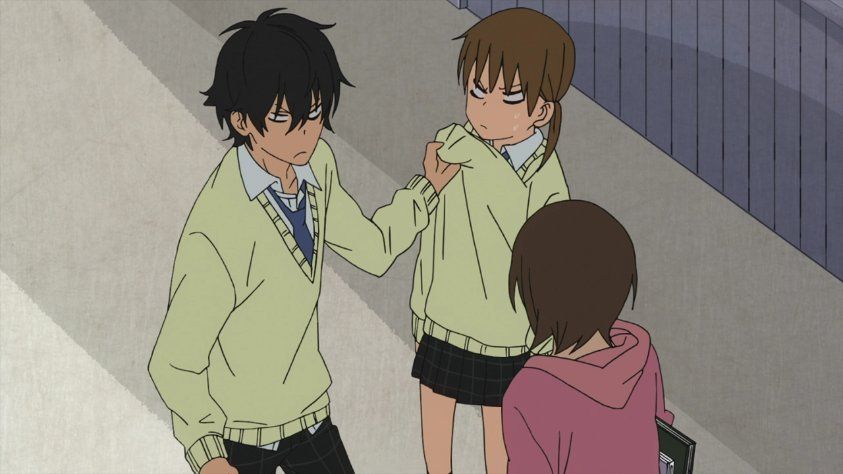
My favorite of the season’s shoujo offerings. Kaibutsukun takes itself quite a bit less seriously than Sukitte Ina Yo, and also hinges less on the “tactically omniscient bishie” factor, spreading the load with a nice sprinkling of cute and effective comedy. And yet somehow, in between monjayaki, social bumbles, idiot classmates, and creepy pet roosters, the show manages to develop the main pair through an eccentric round of confession and acceptance in a pretty emotionally adequate way – and in just two episodes. This isn’t a show you’d expect to break new grounds either, but Brains Base is taking what it has: friends, high school antics, delinquent misunderstood prodigy, socially awkward bookworm, adolescent infatuation, romance, and putting it all together into a smooth, functional piece. The antics are funny, the friends are fun, the romance is cute, the main character development is personal and decently effective. And with the broadness of the show’s focus there is much less danger of the show getting mired on angsty teenage love drama. It is a primarily fun show with just enough emotional investment to make you care about the main characters and their developing romance, and that’s precisely the way I like my shoujo shows.

(And it’s got Tomatsu. In a leading role. And in something quite different from her usual casting. That oughta be enough interesting-points for anybody)
Brainmark #4: Little Busters
Episodes seen: 2
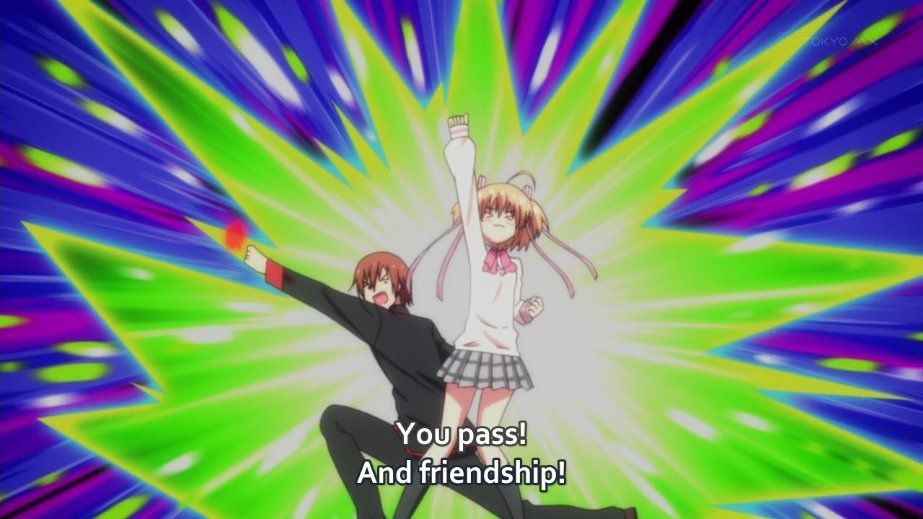
It is inevitable that Little Busters be held to the colossal standards of the best Key-KyoAni works, and at the time of reckoning everyone was of course swift to grimly confirm JC’s unflattering lack of high-level production values with Little Busters. It isn’t even that JC is completely incapable of good production – Little Busters simply didn’t get their A-team. Makes you wonder if JC is deliberately lowering expectations on the outset. Once we’re past that, though, Little Busters is hitting a lot of good buttons. The familiar structure that underlies the early parts of most of Key’s stories: of introducing cute and weird girls while getting into impulsive and dumb activities, all made entertaining with eccentric and witty humor, is well presented enough to draw out smiles and laughter while invoking happy resonances with the earlier Key animes. The production values and animating may not have received the same level of dedication as the Kyoani adaptations, but for the moment they meet the baseline requirements of the storytelling, and should be decent enough to be able to support the rest of the story too: provided the telling remains good. JC has been pretty hit and miss in the past with telling emotionally evocative stories, and if the ominous foreshadowing in these early episodes are any indication, Little Busters is almost guaranteed to transition into one. It’s a Key story after all. Little Busters could become great and intensely memorable, or it could become the flop that people will want to forget a’la the Toei Key adaptations. Everything hinges on JC’s ability to tell a powerful story. For my part, I’ll keep watching with my fingers crossed.
Brainmark #3: Robotic;Notes
Episodes seen: 2
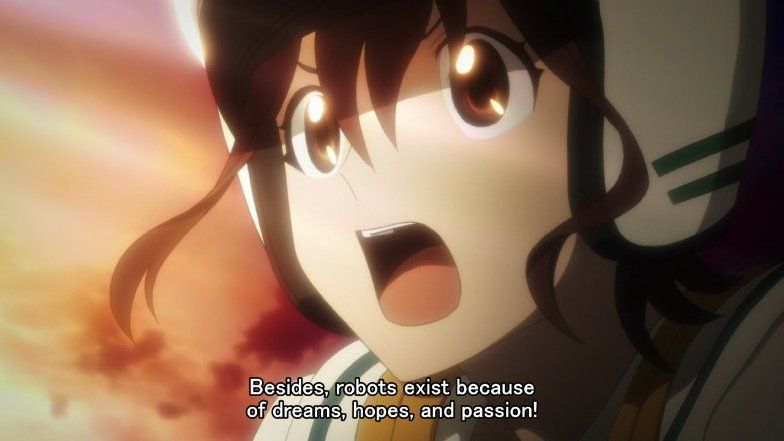
To be honest I’m not sure what to expect of Robotic;Notes. I guess it’s a little sad that a show that I don’t know what to expect of is at number three :) I’ve read that it’s a Visual Novel adaptation (which I guess puts it in direct competition with Little Busters), and that it’s by the same guys who made Chaos;Gate and Steins;Gate. Well, it turns out that I missed out on those two too, so I still don’t really know what to expect. I actually thought it was going to be a cheesy mecha show from the name and the pictures and expected to drop it. It could still be a mecha show, but the opening episodes were nothing like I expected. There’re no giant robots leaping at each other (yet), but it’s got passion, it’s got dreams, it’s got some inkling of love, some inkling of personal hurdle, it’s got relentless positivity, and lots of fight and spirit against adversity. It’s got the smell of adventure, and it’s also got possibly the best tablet app ever animated. IG’s production is solid thus far, and the handling of the pacing and the mood of the show has been quite impeccable.
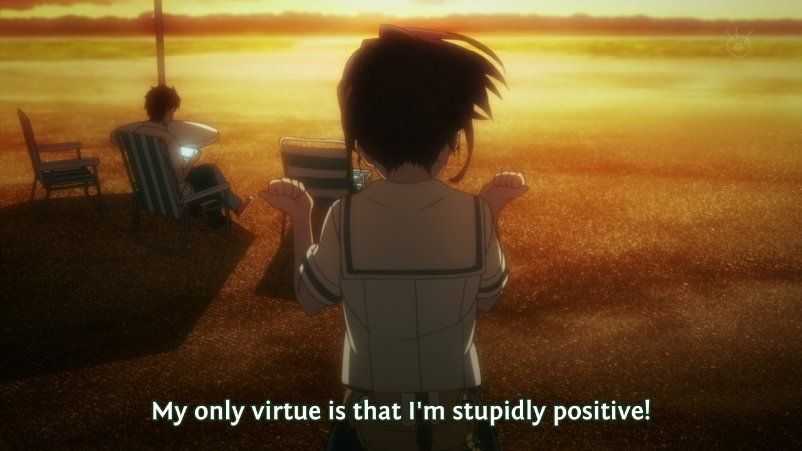
Relentless positivity! I liked this scene. The determination to believe and the will to make something happen is a beautiful thing, and the sunset backdrop and the gentle BGM were pretty spot on. I have very little idea where Robotic;Notes is going to go, but I really enjoyed what I’ve seen so far, and I’m excited to see where we’ll go next. Which is more than I can say for most of the other stuff on air this season.
Brainmark #2: Chuunibyou demo Koi ga Shitai
Episodes seen: 3
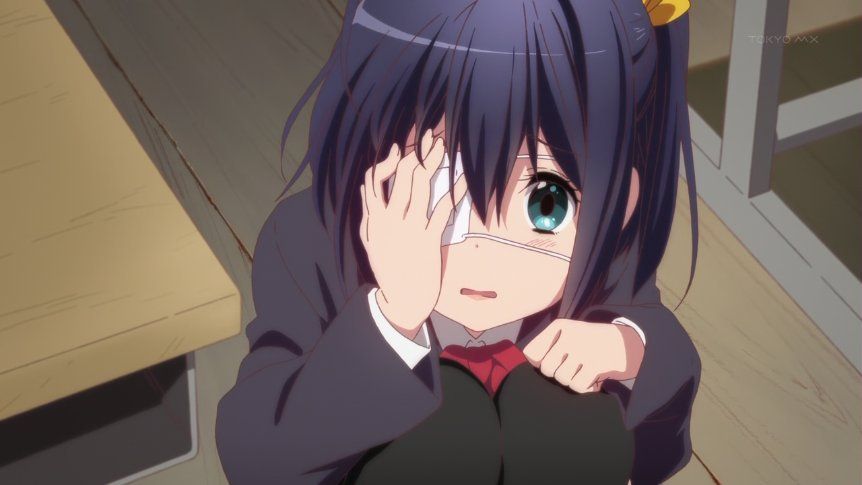
It’s almost embarrassing to admit to it, but Chu2koi is the show I’m enjoying the most by far this season. KyoAni is doing a phenomenal job in what they’ve basically become the world leaders in doing: animating extremely moe girls in high-production backdrops. Hilariously, Chu2koi also has the best fight scenes of the seasonal offerings. It’s really a shame and rather curious that this little corner of KyoAni’s many competencies is so ill-explored – the only show to truly hinge on it being the enigmatically weak Munto. Chu2koi however is creating a cute and brilliant excuse for them to keep flexing their battle-crafting muscles, and I’m loving the result.
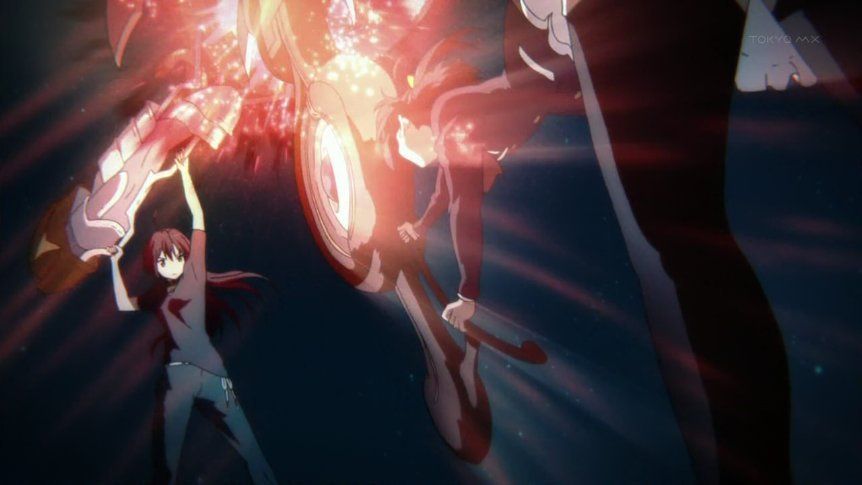
Where is this show going? I don’t really know. It has a K-ON-esque feel to it so far in that everything is so fuwa-fuwa and happy-go-lucky. I’d love for something completely unexpected to come crashing down on the show. I held my breath when Rikka first removed her eye-patch to reveal what disappointingly turned out to be a blindingly bright contact lens. But even if the show continues to stay it’s current silly way, I would be looking forward to watching it every week. KyoAni’s animating prowess is a joy to watch, and everything is just really, really cute. I know that for some people that’s not exactly a good thing – and that’s fine except that the sentiment I feel is starting to transcend mere personal preference. Moe in anime is almost controversial nowadays, with some communities going so far as to call it the cancer of modern anime. The Psycho-Pass staff apparently count themselves among their number. I want to write at length about moe someday, but for the time being, let’s just say that if we needed to pick between Chu2koi and Psycho-Pass for a model for the future of anime, I know where my allegiances lie.
Brainmark #1: Shinsekai Yori
Episodes seen: 2

“From the new world” is my pick for the potential strongest offering of the season. In its first few episodes, A1 managed a magnificent exposition for the show’s chilling, strange world of magic, shadows, creatures, rituals, and dark secrets. A lot of it hinges on the artistic aesthetics. The show utilizes a nice combination of world design, art style, color palette choices, and keening sounds and music to really creep up on the viewer and get under your skin. The world it paints is as vivid as it is disturbing, and yet there are these kids in school engaging in almost normal interactions, leading almost normal adolescent lives, almost blatantly ignoring the strange disappearances of some of their number, as well as the n other things apparently wrong with their world. And that’s the beauty of the storytelling in this early stage of the show: it is as focused as its characters on what normalcy there is in this strange world, and is almost deliberately avoiding looking under the carpet to see the horrors it knows it must find. We see the characters going to school, dining with family, playing in the fields, all the while knowing that unspeakable creatures lurked in the shadows and unanswered questions lingered in the air. It is a beautiful set up to lead into the inevitable phase where we must examine the shadows and face what we find there. What is this new world? What is going on? Well, I daresay we’ll soon find out.
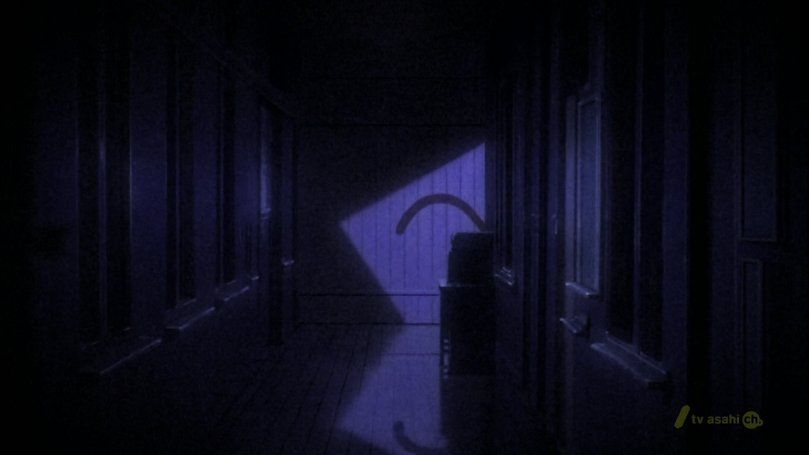
Honorable Mentions: Unserious Shows
Shows like Onichan dakedo Ai Sae Areba Kankeinai yo ne and Kamisama Hajimemashita could easily be garbage with the kind of premises they base themselves on, but a good focus on fun and comedy and a determination to not take themselves seriously make them surprisingly entertaining. Sakurasou no Kanojou also appeared to be in this category, but I hear that there is some fairly serious stuff up ahead for that one.
Dishonorable Mention: Busou Shinki
The mid-air battles between the doll-sized cast is actually pretty cool, which, unfortunately, means nothing more than more money spent on truly atrocious writing. It’s a tragedy that this continues to happen.

No one
I’m surprised that Girls un Panzer escape a dishonorable mention. lol
And Chuunibyou Lite deserves mention as a separate show-in-itself after Ep4 \o/
Jason "moofang"
lol, well, I wasn’t as ired with Girls und Panzer as I was with Busou Shinki. Panzer was just really really.. weird, though I guess the impact has been dampened by the likes of Upotte in the past. Aside from the weirdness the writing is mediocre – but that’s really preferable to the sort of creepy gratuitousness we get in Shinki. Plus, Panzer’s CG was terrible, which probably means not a lot of money and attention went into it. I’m generally okay with trashy shows being trashy all the way through – I’ll just skip it. But when trashy shows appear to get a good budget, I get… disturbed.
Bob Bobertson
Another season already..? Anime moves too fast for me, haven’t even picked anything up this year! Might check out Chuunibyou demo Koi ga Shitai though, can’t go wrong with something from “Jason moofang’s guttural nearly-arbitrary ranking of nearly arbitrarily selected shows” eh?
Jason "moofang"
Well there are as many seasons as there are… seasons (spring summer fall winter) so :)
Metal
I agree with you and I also enjoy Chuunibyou demo Koi ga Shitai a lot for the fall season. Great anime and gets better each episode.